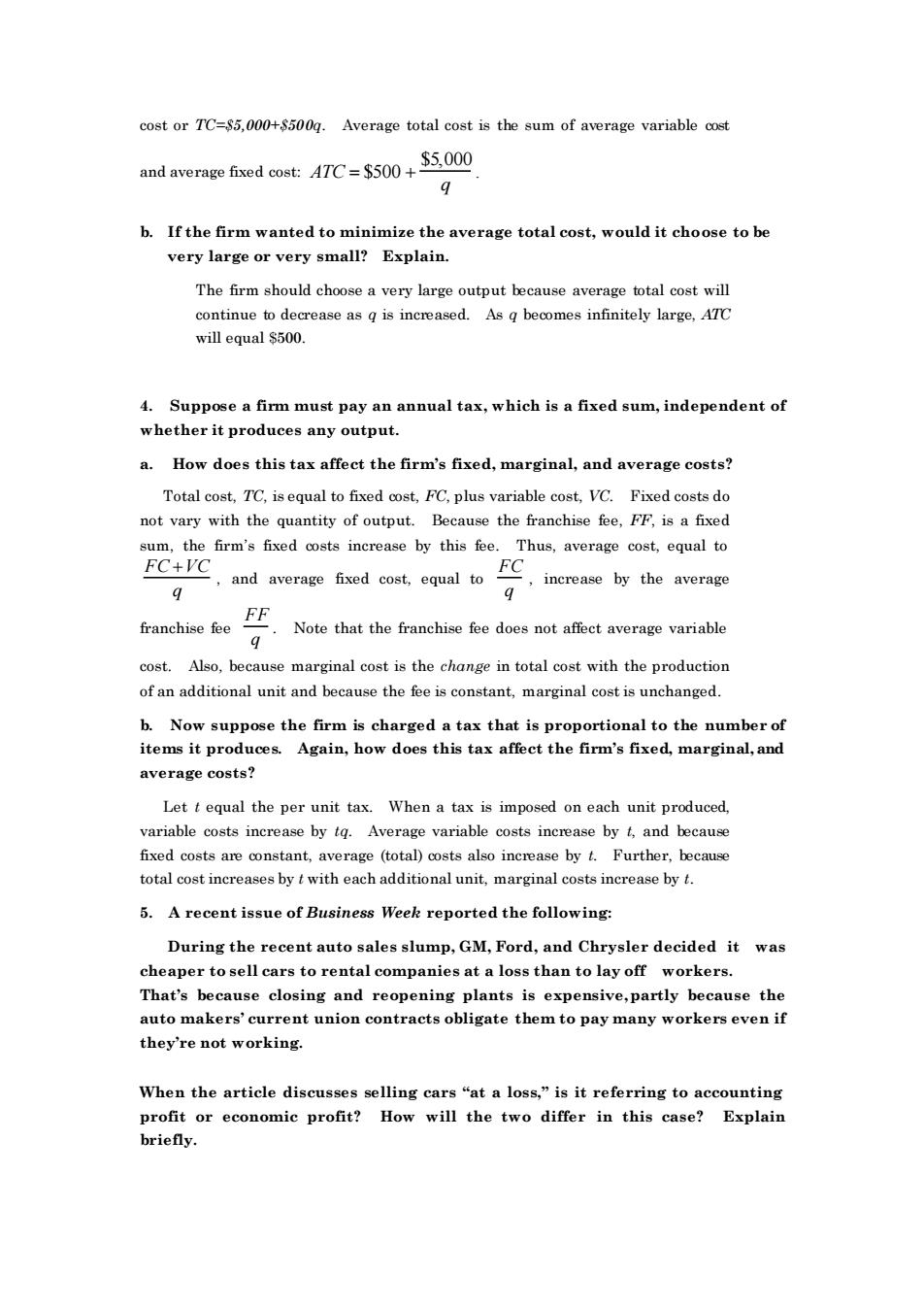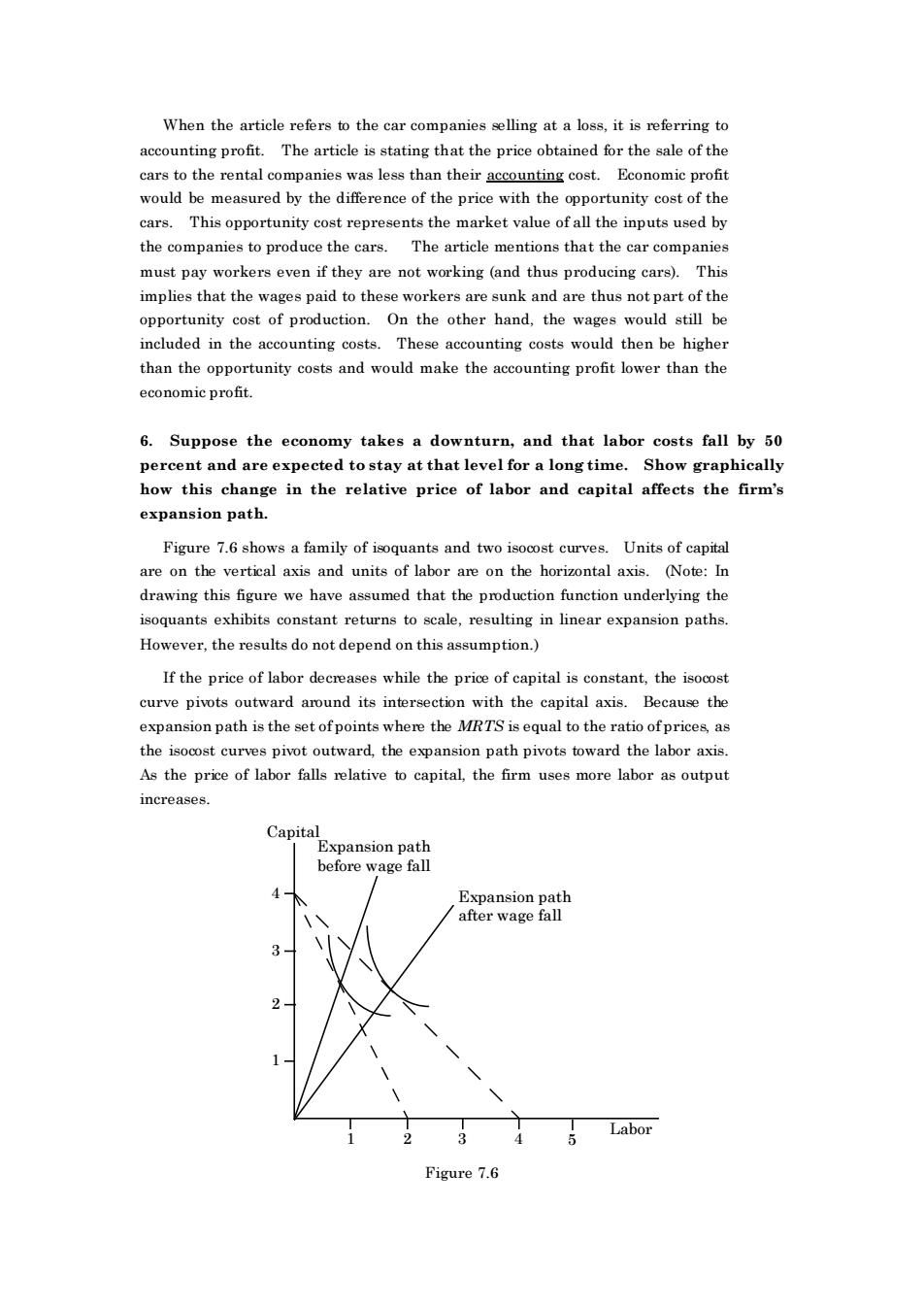
cost or TC=$5,000+8500g.Average total cost is the sum of average variable cost 9 b.If the firm wanted to minimize the average total cost,would it choose to be very large or very small?Explain. The firm should choose a very large output because average total cost will ne s i inced beomee infinitel arge,A 4.Suppose a firm must pay an annual tax,which is a fixed sum,independent of whether it produces any output. a.How does this tax affect the firm's fixed,marginal,and average costs? Total cost TC,is equal to fixed ost FC.plus variable cost,VC.Fixed costs do not vary with the quantity of output.Because the franchise fee,FF,is a fixed sum,the firm's fixed costs increase by this fee.Thus,average cost,equal to FC+VC .and average fixed oqutF increase by the average Note that the franchise fee does not affect average variable cost.Also,because marginal cost is the change in total cost with the production of an additional unit and because the fee is constant,marginal cost is unchanged. b.Now su rtional to the number of Again,how does this tax affect firm's fixe marginal,and average costs? Let t equal the per unit tax.When a tax is imposed on each unit produced, variable costs increase by lq.Average variable costs increase by /and because fixed costs are constant,average (total)costs also increase by.Further.because total cost increases by t with each additional unit,marginal costs increase by t. 5.A recent issue of Business Week reported the following: During the recent auto salesslump,GM,Ford,and Chrysler decided it was r tosell cars to rental companies at a loss than to lay off workers. closing and reopening pats is expesive.parcset auto makers'current union contracts obligate them to pay many workers even if they're not working When the article discusses selling cars"at a loss,"is it referring to ac counting How will the two differ in this case?Explain
cost or TC=$5,000+$500q. Average total cost is the sum of average variable cost and average fixed cost: ATC = $500 + $5,000 q . b. If the firm wanted to minimize the average total cost, would it choose to be very large or very small? Explain. The firm should choose a very large output because average total cost will continue to decrease as q is increased. As q becomes infinitely large, ATC will equal $500. 4. Suppose a firm must pay an annual tax, which is a fixed sum, independent of whether it produces any output. a. How does this tax affect the firm’s fixed, marginal, and average costs? Total cost, TC, is equal to fixed cost, FC, plus variable cost, VC. Fixed costs do not vary with the quantity of output. Because the franchise fee, FF, is a fixed sum, the firm’s fixed costs increase by this fee. Thus, average cost, equal to FC +VC q , and average fixed cost, equal to FC q , increase by the average franchise fee FF q . Note that the franchise fee does not affect average variable cost. Also, because marginal cost is the change in total cost with the production of an additional unit and because the fee is constant, marginal cost is unchanged. b. Now suppose the firm is charged a tax that is proportional to the number of items it produces. Again, how does this tax affect the firm’s fixed, marginal, and average costs? Let t equal the per unit tax. When a tax is imposed on each unit produced, variable costs increase by tq. Average variable costs increase by t, and because fixed costs are constant, average (total) costs also increase by t. Further, because total cost increases by t with each additional unit, marginal costs increase by t. 5. A recent issue of Business Week reported the following: During the recent auto sales slump, GM, Ford, and Chrysler decided it was cheaper to sell cars to rental companies at a loss than to lay off workers. That’s because closing and reopening plants is expensive,partly because the auto makers’ current union contracts obligate them to pay many workers even if they’re not working. When the article discusses selling cars “at a loss,” is it referring to accounting profit or economic profit? How will the two differ in this case? Explain briefly

When the article refers to the car companies selling at a loss,it is referring to accounting profit.The article is stating that the price obtained for the sale of the cars to the rental companies was less than theirac inting cost. Economie prof would be measured by the difference of the price with the opportunity cost of th cars.This opportunity cost represents the market value of all the inputs used by the companies to produce the cars.The article mentions that the car companies must pay workers even if they are not working(and thus producing cars). This implies that the to these workerre dare thus notpart opportnitotO the atherd.the included in the accounting costs.These accounting costs would then be higher than the opportunity costs and would make the accounting profit lower than the economic profit. 6.Suppose the economy takes a downturn,and that labor costs fall by 50 percent and are expected to stay at that level for a long time.Show graphically how this change in the relative price of labor and capital affects the firm's expansion path. Figure 7.6 shows a family of isoquants and two isocost curves.Units of capital function underlying th isoquants exhibits constant returns to scale,resulting in linear expansion paths However.the results do not depend on this assumption.) If the price of labor decreases while the price of capital is constant.the isocost curve pivots outward around its intersection with the capital axis.Because the expansion path is the set of points where the ratio of pricesas es pivo outward,the expanion path pivots toward the labor axis As the price of labor falls relative to capital,the firm uses more labor as output increases. Capital Expansion path before wage fall Labo Figure 7.6
When the article refers to the car companies selling at a loss, it is referring to accounting profit. The article is stating that the price obtained for the sale of the cars to the rental companies was less than their accounting cost. Economic profit would be measured by the difference of the price with the opportunity cost of the cars. This opportunity cost represents the market value of all the inputs used by the companies to produce the cars. The article mentions that the car companies must pay workers even if they are not working (and thus producing cars). This implies that the wages paid to these workers are sunk and are thus not part of the opportunity cost of production. On the other hand, the wages would still be included in the accounting costs. These accounting costs would then be higher than the opportunity costs and would make the accounting profit lower than the economic profit. 6. Suppose the economy takes a downturn, and that labor costs fall by 50 percent and are expected to stay at that level for a long time. Show graphically how this change in the relative price of labor and capital affects the firm’s expansion path. Figure 7.6 shows a family of isoquants and two isocost curves. Units of capital are on the vertical axis and units of labor are on the horizontal axis. (Note: In drawing this figure we have assumed that the production function underlying the isoquants exhibits constant returns to scale, resulting in linear expansion paths. However, the results do not depend on this assumption.) If the price of labor decreases while the price of capital is constant, the isocost curve pivots outward around its intersection with the capital axis. Because the expansion path is the set of points where the MRTS is equal to the ratio of prices, as the isocost curves pivot outward, the expansion path pivots toward the labor axis. As the price of labor falls relative to capital, the firm uses more labor as output increases. Capital Labor 2 1 3 4 1 2 3 4 5 Expansion path before wage fall Expansion path after wage fall Figure 7.6